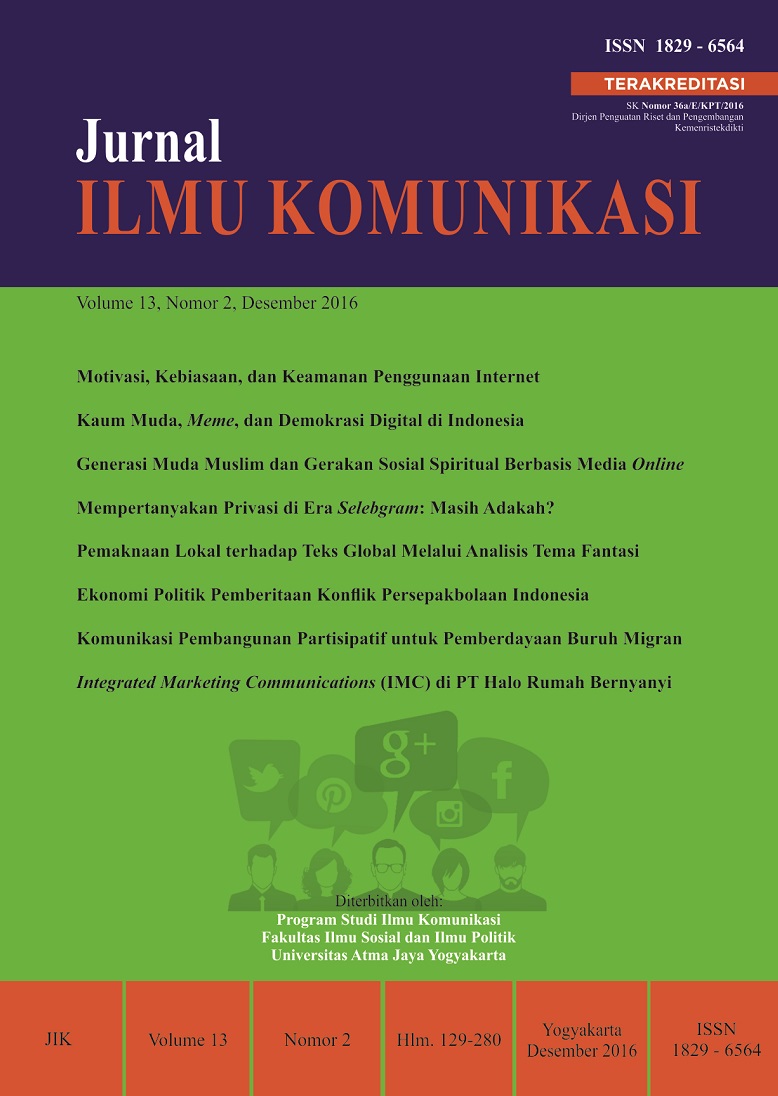Ekonomi Politik Pemberitaan Konflik Persepakbolaan Indonesia
DOI:
https://doi.org/10.24002/jik.v13i2.673Abstract
Abstract: This study reveals the interests behind football conflicts news in three newspapers in Indonesia: Kompas, Bola, and Seputar Indonesia. The analysis is based on the political economy of media theory developed by Vincent Mosco, Graham Murdock, and Peter Golding. Using critical paradigm with Norman Fairclough’s model of Critical Discourse Analysis (CDA) method, the findings show that the conflicts in Indonesian football have been produced as issues that legitimate the strategic position of the football elite power. The media and journalists were drag into the creation or the legitimation of football elite domination.
Keywords: critical discourse analysis, football, political economy of media
Abstrak: Penelitian ini mengungkap kepentingan di balik pemberitaan konflik persepakbolaan Indonesia di tiga media cetak, yakni Kompas, Bola dan Seputar Indonesia. Analisis didasarkan pada teori ekonomi politik media yang dikembangkan oleh Vincent Mosco, Graham Murdock, dan Peter Golding. Penelitian ini menggunakan paradigma kritis dengan metode Critical Discourse Analysis (CDA) model Norman Fairclough. Hasil penelitian menunjukkan bahwa peristiwa konflik persepakbolaan Indonesia diproduksi menjadi isu yang melegitimasi posisi strategis kekuasaan elit persepakbolaan. Media dan wartawan terseret dalam penciptaan atau pengukuhan kekuasaan dominasi elit persepakbolaan tersebut.
Kata Kunci: analisis wacana kritis, ekonomi politik media, sepak bola
Downloads
Published
How to Cite
Issue
Section
License
Jurnal ILMU KOMUNIKASI is an academic journal. As such, it is dedicated to the open exchange of information. For this reason, JIK is freely available to individuals and institutions. Authors who publish in Jurnal ILMU KOMUNIKASI will release their articles under the Creative Commons Attribution (BY) License. This license allows anyone to copy and redistribute the article in any medium or format as well as remix, transform, and build upon the material for any purpose, even commercially as long as they credit the authors for the original creation. For details of the rights authors grants users of their work, see the "human-readable summary" of the license, with a link to the full license. (Note that "you" refers to a user, not an author, in the summary)
 This work is licensed under a Creative Commons Attribution 4.0 International License.
This work is licensed under a Creative Commons Attribution 4.0 International License.














